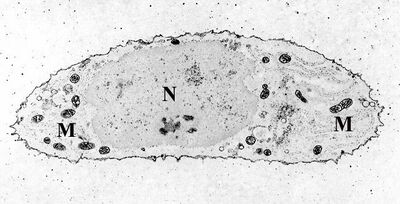Biology:Cytochemistry

Cytochemistry is the branch of cell biology dealing with the detection of cell constituents by means of biochemical analysis and visualization techniques. This is the study of the localization of cellular components through the use of staining methods.[1] The term is also used to describe a process of identification of the biochemical content of cells. Cytochemistry is a science of localizing chemical components of cells and cell organelles on thin histological sections by using several techniques like enzyme localization, micro-incineration, micro-spectrophotometry, radioautography, cryo-electron microscopy, X-ray microanalysis by energy-dispersive X-ray spectroscopy, immunohistochemistry and cytochemistry, etc.[2]
Freeze Fracture Enzyme Cytochemistry
Freeze fracture enzyme cytochemistry was initially mentioned in the study of Pinto de silva in 1987.[3] It is a technique that allows the introduction of cytochemistry into a freeze fracture cell membrane. immunocytochemistry is used in this technique to label and visualize the cell membrane's molecules. This technique could be useful in analyzing the ultrastructure of cell membranes.[4] The combination of immunocytochemistry and freeze fracture enzyme technique, research can identify and have a better understanding of the structure and distribution of a cell membrane.[5]
Origin
Jean Brachet's research in Brussel demonstrated the localization and relative abundance between RNA and DNA in the cells of both animals and plants opened up the door into the research of cytochemistry. The work by Moller and Holter in 1976 about endocytosis which discussed the relationship between a cell's structure and function had established the needs of cytochemical research.[6]
Aims
Cytochemical research aims to study individual cells that may contain several cell types within a tissue. It takes a nondestructive approach to study the localization of the cell. By remaining the cell components intact, researcher are able to study the intact cell activity rather than studying an isolated biochemical activity which the result may be influenced by the distorted cell membrane and spatial difference.[6]
References
- ↑ Matoušková, Martina; Bílý, Tomáš; Bruňanská, Magdaléna; Mackiewicz, John S.; Nebesářová, Jana (October 2018). "Ultrastructural, cytochemistry and electron tomography analysis of Caryophyllaeides fennica (Schneider, 1902) (Cestoda: Lytocestidae) reveals novel spermatology characteristics in the Eucestoda" (in en). Parasitology Research 117 (10): 3091–3102. doi:10.1007/s00436-018-6001-9. ISSN 0932-0113. PMID 30022291. http://link.springer.com/10.1007/s00436-018-6001-9.
- ↑ Nagata, T (2001). "Special cytochemistry in cell biology". International Review of Cytology 211: 33–151. doi:10.1016/s0074-7696(01)11017-x. ISBN 9780123646156. PMID 11597006.
- ↑ Electron microscopy of proteins. James R. Harris. London: Academic Press, a subsidiary of Harcourt Brace Jovanovich. 1981. ISBN 0-12-327601-2. OCLC 8211543. https://www.worldcat.org/oclc/8211543.
- ↑ Takizawa, T.; Saito, T. (1996-06-01). "Freeze-Fracture Enzyme Cytochemistry: Application of Enzyme Cytochemistry to Freeze-Fracture Cytochemistry" (in en). Journal of Electron Microscopy 45 (3): 242–246. doi:10.1093/oxfordjournals.jmicro.a023440. ISSN 0022-0744. PMID 8765719. https://academic.oup.com/jmicro/article-lookup/doi/10.1093/oxfordjournals.jmicro.a023440.
- ↑ Takizawa, T.; Saito, T. (1997-01-01). "New fracture-labelling method: alkaline phosphatase in unstimulated human neutrophils" (in en). Journal of Electron Microscopy 46 (1): 85–91. doi:10.1093/oxfordjournals.jmicro.a023494. ISSN 0022-0744. PMID 9090859. https://academic.oup.com/jmicro/article-lookup/doi/10.1093/oxfordjournals.jmicro.a023494.
- ↑ 6.0 6.1 Chayen, J. (1980). The cytochemical bioassay of polypeptide hormones. Berlin: Springer-Verlag. ISBN 0-387-10040-7. OCLC 6196519. https://www.worldcat.org/oclc/6196519.
- Brighton, Carl T. and Robert M. Hunt (1974). "Mitochondrial calcium and its role in calcification". Clinical Orthopaedics and Related Research 100: 406–416.
- Brighton, Carl T. and Robert M. Hunt (1978). "The role of mitochondria in growth plate calcification as demonstrated in a rachitic model". Journal of Bone and Joint Surgery, 60-A: 630–639.
 |

